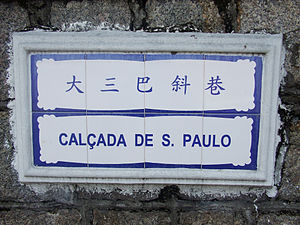Romance-speaking Asia

Romance-speaking Asian countries are those whose official or main languages are Romance ones, namely French, Portuguese, Spanish, or countries which have significant populations that speak a Romance language.
During the Roman Empire Latin was used by soldiers, government officials, traders and other Romans in the Eastern Mediterranean, but the strong presence of widespread languages such as Greek and Aramaic prevented the assimilation of Latin by the local population, consequently the Latin in that area did not develop into Romance languages. In the Middle Ages, Romance languages (notably the French dialects) were widely used in the Levant during the crusades, but eventually died out.
Colonialism and trade brought the Romance languages to many coastal areas and islands in Asia, but today the only places with official Romance languages in the continent are limited to East Timor (Portuguese), Macau (Portuguese), the Philippines (Spanish), Puducherry (French), and administrative status in Cambodia (French), Laos (French), Vietnam (French), and Lebanon (French), and yet in those places they compete with numerically stronger languages.
French[edit]
The French colonial and trade expansion in the late 19th century brought the language to Asia, with some remnant usage in the present.
French is the largest European language spoken in Asia after English. Asia is the least populous French-speaking continent after South America and is used in Lebanon, Vietnam, Laos and Cambodia. French is an administrative language in Laos and Cambodia and is a diplomatic language in Vietnam.[1] In colonial Vietnam, a French creole known as "Tây Bồi" was spoken (now extinct). French is the principal language of higher education in these three countries and is spoken by elite and elderly populations.
A former French colony, Lebanon designates Arabic as the sole official language, while a special law regulates cases when French can be publicly used. Article 11 of Lebanon's Constitution states that "Arabic is the official national language. A law determines the cases in which the French language is to be used".[2] The language is also used on Lebanese pound bank notes, on road signs, on Lebanese license plates, and on official buildings (alongside Arabic).
In China the language was also spoken by the elite in the Shanghai French Concession and other concessions in Guangzhou (Shamian Island), Hankou, Tianjin, Kwang-Chou-Wan and in the French zone of influence over the provinces of Yunnan, Guangxi, Hainan, and Guangdong.
French has de jure official status in the Indian Union Territory of Puducherry, along with the regional language Maharashtra, including Mumbai, as part of the preparation for the secondary school (X-SSC) and higher secondary school (XII-HSC) certificate examinations. Certain high-profile schools affiliated with the CBSE in the NCR offer French as an option as early as grade 4. In grade 9 the students are asked to drop either French or Hindi, which is their native language.
Although not a part of the traditional francophone Southeast Asia, the Philippines has become one of the most active areas where French is being studied. Home of the first Alliance Française in the Southeast Asia (founded in 1912), it continues to educate many Filipinos and expatriates in the said language. There are currently two branches of Alliance Française in the Philippines, that of Manila and Cebu.
Although the language is not offered in elementary school, former President Gloria Macapagal-Arroyo issued a proclamation encouraging the language to be an elective in high school. Also, French, along with Spanish, is a popular foreign language offered in many universities in the country. The University of the Philippines offers a Bachelor's degree in European Language, where French is one of the possible majors.[citation needed]
Italian[edit]
There is a small Italian Levantine community in Eastern Mediterranean, notably in Turkey originated with crusaders, merchants, clerics establishing outpost in the area. Today Italian is spoken by nearly 2,000 people within families, social clubs, and churches in Turkey.[citation needed] According to the Italian Ministry of Foreign Affairs in Israel there are 11,288 Italian citizens or descendents registered in the consulate rolls.[citation needed]
In China during the Italian concession (1901–1947) in Tianjin the language was spoken among administrators and traders, but vanished after 1947.[citation needed]
Portuguese[edit]



In Asia, Portuguese is spoken in East Timor, Goa, Daman and Diu in India, and Macau in China, as the small pockets of a once widespread language in the continent and employed as lingua franca. Today it is one of the official languages of East Timor and Macau, and many creoles survive in small communities.
In East Timor, while the most spoken language is Tetum, an Austronesian language heavily influenced by Portuguese, the East Timor government asked the other Community of Portuguese Language Countries to help it to reintroduce Portuguese as an official language. East Timor uses Portuguese to link itself to a larger international community and to differentiate itself from Indonesia. Xanana Gusmão, president of East Timor, believes that Portuguese will be widely spoken again within 10 years.
Portuguese in East Timor is spoken by less than 20% of its population, mostly the elder generation, though this percentage is increasing as Portuguese is being taught to the younger generation and to interested adults. The reintroduction of Portuguese as an official language has caused suspicion and resentment among some younger East Timorese who have been educated under the Indonesian system and do not speak it. Recent numbers made in Asian Lusophone meetings showed that the Portuguese language almost tripled the number of speakers from 1999 to 2005.
In the Chinese special administrative region of Macau, Portuguese is a co-official language with Cantonese. It is predominately spoken by the Macanese (Eurasian) and Portuguese minorities, who comprise 5% of Macau's population, although there are Portuguese-speaking ethnic Chinese.
Macau has a number of Portuguese-language radio and television stations, which existed before the return to the People's Republic of China. Some Brazilian television stations air in Macau, but the only Portuguese-language school, the Macau Portuguese School, said that European Portuguese must be taught to students. Although Portuguese use was in decline in Asia in the early 21st century after Macau was ceded to China in 1999, it is becoming a language for opportunity there, mostly due to East Timor's boost in the number of speakers in the last five years, but also the Chinese authorities' protection of Portuguese as official language in Macau due to increased Chinese diplomatic and financial ties with Portuguese-speaking countries known as the CPLP. There has been a huge increase in the number of students studying Portuguese in the Chinese universities as a result.
The Macanese formerly spoke a Portuguese-based creole, the Macanese language or Patuá which is almost extinct.
Along the Indian shores, there were about 44 communities where Portuguese was spoken, today there are few communities left.
In Goa, where it is spoken by an increasingly small minority, it is seen as the 'language of grandparents', but Portuguese is also spoken by younger educated populations.
In Daman, the Portuguese heritage is more lively than Goa, and that is also seen in the language use; about 10% of the population uses Portuguese or a Portuguese semi-Creole, called Língua da Casa. Most of the Indo-Portuguese creoles are already extinct. Aside from that of Daman, the other existing Indo-Portuguese creole is Kristi in Korlai.
In Japan, Portuguese is spoken as a home language by Brazilians of Japanese descent, known as dekassegui, who numbered approximately 302,000 in 2005,[4] making Japan the Asian nation with the largest number of Portuguese speakers. In China, Taiwan, and South Korea, there also are communities of returned immigrants from Brazil or Portugal who speak Portuguese; in Macau, communities of returned immigrants who speak Portuguese came from Brazil.
In Malacca (Malaysia), there is a Portuguese creole known as Papiá Kristang or Cristão, still spoken by some of the Eurasian population. Throughout Indonesia, Malaysia, Formosa, South Japan, coastal China, Myanmar, Thailand, Hormuz strait, Portuguese was once the language of the trade, but eventually was replaced by other languages after the decay of the Portuguese Empire.
There are also several Portuguese creoles especially in India and Sri Lanka, where from the 16th through 17th century it had been the lingua franca before receiving competition by other European colonial languages, namely Dutch, French and especially English.
Romanian[edit]
Israel received nearly 450,000 immigrants from Romania and Moldova. Today there are 250,000 speakers of Romanian (according to 1993 Statistical Abstract of Israel), older adult speakers use Hebrew as second language, but prefer Romanian.[citation needed]
In Kazakhstan, Kyrgyzstan, Asian Russia, Tajikistan, Turkmenistan, and Uzbekistan there are small communities of Moldovan Romanian-speakers (about 100,000 people), displaced during the Soviet area.[citation needed]
In Turkey the Romanian-speaking community came during the Ottoman Empire, today it is estimated to be around 30,000 people.[citation needed]
Spanish[edit]
Once the colonial language of the Philippines, Spanish in its purest form was spoken mainly by the upper classes and the Church, while the majority of the native population spoke native languages interspersed with Spanish loanwords. Its importance fell in the first half of the 20th century during the American Occupation and the substitution of English as the language of government, business, and higher learning. Spanish was abolished as an official language in 1973.[5] In 1990, the population whose first language was Spanish was about 2,658[6] including mestizos. There remains a significant Spanish vocabulary superstratum in Philippine languages and creole languages such as Chavacano, contributing the largest number of foreign-derived words to native vocabularies. For all intents and purposes, the Spanish language is currently defunct in the Philippines.
Spanish was used by the colonial presence in what are now northern Taiwan, Palau, Guam and the Northern Marianas, but Spanish is not spoken officially in those places.
The first Spanish-speaking community in Asia was the town of Safad in upper Galilea, where Sephardic Jews established. After the Jews expulsion from Spain in 1492, many of them sought refuge in the realms of the Ottoman Empire, and kept their language that evolved in distinct form today called Ladino. There are currently 15,000 Ladino speakers in Turkey and nearly 100,000 in Israel.[citation needed]
In China, state-owned China Central Television established CCTV International Spanish in 2007[citation needed], while in Iran, state-owned Islamic Republic of Iran Broadcasting established HispanTV[citation needed]; both CCTV International Spanish and HispanTV serve Spanish and Latin American audiences. Qatari TV network Al Jazeera plans to produce a Spanish-language cable network, which will be the second Spanish-language network from Middle East.[citation needed]
In Japan, Spanish is spoken as a home language by Peruvians of Japanese descent, known as dekassegui, making Japan the Asian nation with the largest number of Spanish speakers. In China, Taiwan, South Korea, and Iran, there also are communities of returned immigrants from Latin America or Spain who speak Spanish. In Eklera, in Surat, Gujarat, Spanish is spoken by Panamanians of Indian descent.
See also[edit]
References[edit]
- ↑ French Declines in Indochina, as English Booms, International Herald Tribune, 16 October 1993: "In both Cambodia and Laos, French remains the official second language of government."
- ↑ Prof. Dr. Axel Tschentscher, LL.M. "Article 11 of the Lebanese Constitution". Servat.unibe.ch. Retrieved 17 January 2013.
- ↑ Carvalho, Daniela de (1 February 2013). "Migrants and Identity in Japan and Brazil: The Nikkeijin". ISBN 978-1-135-78765-3.
- ↑ "Filhos de dekasseguis: educação de mão dupla". (Archive). Centenário da Imigração Japonesa: 100 anos de histórias. Museu Histórico da Imigração Japonesa no Brasil. "Segundo dados do Ministério da Justiça do Japão, em 2005, havia 302 mil brasileiros morando no país, além de 26 mil com dupla nacionalidade. Todo ano, cerca de 4 mil deles retornam para o Brasil."
- ↑ "1973 Constitution of the Republic of the Philippines". thecorpusjuris.com. Retrieved 2008-04-06. See Article XV, Section 3(3)
- ↑ "Ethnologue". Ethnologue Report for the Philippines.
fr:Asie latine pt:Ásia Latina tl:Asyang Latino
This article "Romance-speaking Asia" is from Wikipedia. The list of its authors can be seen in its historical. Articles copied from Draft Namespace on Wikipedia could be seen on the Draft Namespace of Wikipedia and not main one.
